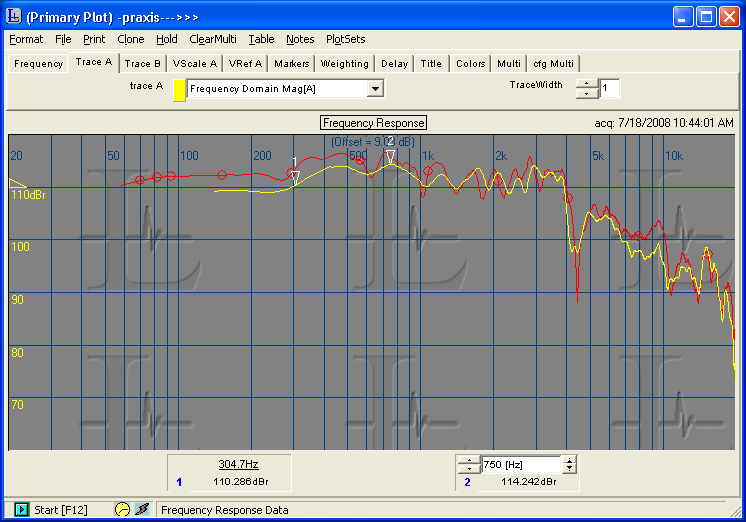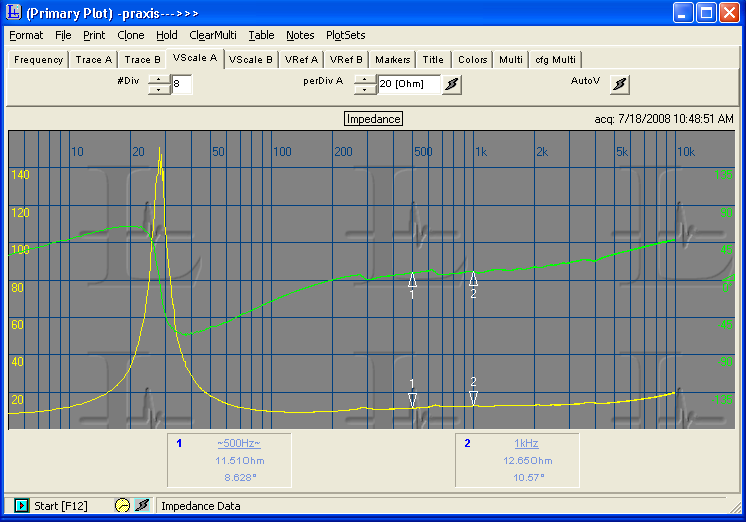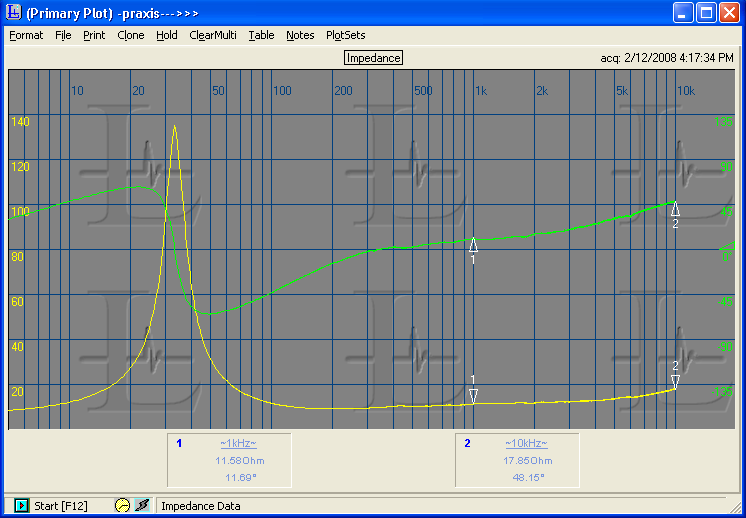Hi,
Here is an alternative waveguide in the works.
http://www.aespeakers.com/phpbb2/viewtopic.php?f=3&t=1700
Have fun!
NW
Here is an alternative waveguide in the works.
http://www.aespeakers.com/phpbb2/viewtopic.php?f=3&t=1700
Have fun!
NW
I really need to get around to measuring exact data for every driver one of these years. My time has just been consumed with getting this new 6.5" high efficiency driver out, our AV woofers back to market, and about a million other things. I have a few curves of interest. These are unsmoothed curves. This first one is a TD15M response curve, semi close mic, about 3" from the cone. Ignore the red curve as my time gating went too long and it picked up some room reflections. Yellow curve is of interest, again this is unsmoothed.

here is the impedance curve for the TD15M.

Here is an impedance curve from the TD12M which may be of great interest for this application:

I don't have a response curve for the TD12M on here, but it is extremely smooth as well.
As far as the waveguide goes, that is my next project to get in order after the 6.5" and AV woofers are ready next week. We saw some definite need as it seems all the good options have some issue with availability, quality control, difficult mounting of the drivers and or to the cabinet, etc. We wanted something that performs well, is easy to mount, has a unique and attractive look, and is something we can hand make here in the US with short lead times.
John
here is the impedance curve for the TD15M.
Here is an impedance curve from the TD12M which may be of great interest for this application:
I don't have a response curve for the TD12M on here, but it is extremely smooth as well.
As far as the waveguide goes, that is my next project to get in order after the 6.5" and AV woofers are ready next week. We saw some definite need as it seems all the good options have some issue with availability, quality control, difficult mounting of the drivers and or to the cabinet, etc. We wanted something that performs well, is easy to mount, has a unique and attractive look, and is something we can hand make here in the US with short lead times.
John
I'm in for a pair of the waveguides when they're available, definitely does seem to be a lack of alternatives.
Norris Wilson said:Hi,
Here is an alternative waveguide in the works.
http://www.aespeakers.com/phpbb2/viewtopic.php?f=3&t=1700
 Wow.. my thread over there sure got popular lol (BHTX84 = me).
Wow.. my thread over there sure got popular lol (BHTX84 = me).edit: Oh, only 724 views.. ok maybe not.
Recently I saw a very nice FR of a 12" RFT. Would be sad to cross it at 1.6 kHz, however.
http://cgi.ebay.de/2-x-PA-Lautsprec...39:1|66:2|65:12|240:1318&_trksid=p3286.c0.m14
http://cgi.ebay.de/2-x-PA-Lautsprec...39:1|66:2|65:12|240:1318&_trksid=p3286.c0.m14
You need a woofer with a great x-max.
I found a good dipool 12" in the visaton W300. X-max 14mm
visaton
I found a good dipool 12" in the visaton W300. X-max 14mm
visaton
An externally hosted image should be here but it was not working when we last tested it.
I suppose that one is W300S...how do you get 14mm(p-p)Xmax when poleplate is 8mm and voicecoil is 18,5mm...just a friendly remark, and I reckon 10mm is still plenty 🙂
tinitus said:... how do you get 14mm(p-p)Xmax when poleplate is 8mm and voicecoil is 18,5mm ...
Visaton is giving Xmax (p-p) as 28 mm and Xlin= +/- 5 mm.
Rudolf said:
Visaton is giving Xmax (p-p) as 28 mm and Xlin= +/- 5 mm.
Since there is no set standard, companies often denote things that can be a little confusing. With a top plate thickness of 8mm and an 18.5mm coil you have approximately 5.5mm overhang on either side. This gives a good indication of their Xlin, which would essentially be the point at which the Bl drops to 70%. Xlin doesn't make too much sense as the Bl isn't linear over that range, it still drops 30%. Xmag and Xsus are much more clear, Xmag being the magnetic Xmax to 70% of the rest BL, and Xsus as the suspension limits of the driver. Xmax is then the lesser of the two.
A driver with no shorting ring and high 1.8mH inductance isn't going to be too usable past 200-250hz IMO. Without a shorting ring, it's also going to have serious issues with flux modulation as you get the driver moving to higher excursions, which is a given in an OB where you need to apply boost at the low end. See our paper on Designing for Low Distortion: https://www.aespeakers.com/Lambda001-1.php
The Visaton is also only 92dB 1W. If you aren't needing much senstivity but want more Xmax, our TD12X, H, and S are all options with a full 14mm Xmax, much lower inductance, lower distortion, higher bandwidth, more efficiency, etc. The TD12S has the highest Q out of all of them so is probably the most suited for an open baffle: https://www.aespeakers.com/drivers.php?driver_id=11
John
Comparing the Beyma 12g40 and 12MI100 (supposedly their "best" midrange) I'm confused - distortion is lower on the 12g40, response is flatter, inductance is lower, and it's cheaper. Am I missing something?
12MI100
Resonant Frequency (fs) 58 Hz
Impedance (Re) 6.3 ohms
Coil Inductance (Le) 2.3 mH
Mechanical Q (Qms) 5.54
Electrical Factor(Qes) .23
Total Q (Qts) .22
Comp. Equivelant Vol. (Vas) 2.26 ft3 / 64 Liters
Voice Coil Overhang (Xmax) 2.0 mm
Surface Area of Cone (Sd)m2 0.0530m2
Reference Efficiency 5.1%
Displacement Volume (Vd) 105 cm3
12g40
Resonant Frequency (fs) 44 Hz
Impedance (Re) 6.0 ohms
Coil Inductance (Le) 2.1 mH
Mechanical Q (Qms) 11.6
Electrical Factor(Qes) .3
Total Q (Qts) .3
Comp. Equivelant Vol. (Vas) 2.86 ft3 / 81 Liters
Voice Coil Overhang (Xmax) 6.0 mm
Surface Area of Cone (Sd)m2 0.0530m2
Reference Efficiency 2.3%
Displacement Volume (Vd) 316 cm3
distortion plots on http://www.usspeaker.com/homepage.htm for those interested
12MI100
Resonant Frequency (fs) 58 Hz
Impedance (Re) 6.3 ohms
Coil Inductance (Le) 2.3 mH
Mechanical Q (Qms) 5.54
Electrical Factor(Qes) .23
Total Q (Qts) .22
Comp. Equivelant Vol. (Vas) 2.26 ft3 / 64 Liters
Voice Coil Overhang (Xmax) 2.0 mm
Surface Area of Cone (Sd)m2 0.0530m2
Reference Efficiency 5.1%
Displacement Volume (Vd) 105 cm3
12g40
Resonant Frequency (fs) 44 Hz
Impedance (Re) 6.0 ohms
Coil Inductance (Le) 2.1 mH
Mechanical Q (Qms) 11.6
Electrical Factor(Qes) .3
Total Q (Qts) .3
Comp. Equivelant Vol. (Vas) 2.86 ft3 / 81 Liters
Voice Coil Overhang (Xmax) 6.0 mm
Surface Area of Cone (Sd)m2 0.0530m2
Reference Efficiency 2.3%
Displacement Volume (Vd) 316 cm3
distortion plots on http://www.usspeaker.com/homepage.htm for those interested
Ang said:Comparing the Beyma 12g40 and 12MI100 (supposedly their "best" midrange) I'm confused - distortion is lower on the 12g40, response is flatter, inductance is lower, and it's cheaper. Am I missing something?
haha.. yeah, I've noticed that before too. I think US Speaker is just full of bull on that one. However, inductance is higher.. but with higher Fs and lower Qts and only 2mm of Xmax, it IS more suited to strictly midrange duty, whereas the 12g40 could play quite a bit lower. Maybe they took that into consideration, I dunno. Regardless, I wouldn't even consider the 12MI100 for a 2-way. Anyway, their prices are often a lot higher than others too. And let's not forget all the jacked up DDS waveguides that were coming from there.. dunno what that was all about, but people ordering them from Assistance Audio supposedly didn't have any problems with theirs. I think it was just the bolt-on versions from US Speaker that were so messed up. Even after all this, I still visit the site frequently, but haven't ordered anything from them. I just look. 🙂
Anyway, for what those drivers cost, you'd be crazy not to take mine instead.. lol. They're not much different, and actually better in several ways. IMO.. either save a TON of money, or go all out and spend a lot more to get the REAL deal from John (which certainly isn't a bad deal either, considering the prices of everything else.. which is mainly why I'm making this suggestion). Like everyone else, all I've seen of the Lambda drivers are some simple response graphs, but I don't doubt they're not the top most quality you can possibly get from anywhere, as far as those kinds of woofers are concerned. I think the decision you made in your reply to me the other day was a good one. It just depends on how much you're willing to spend. For the absolute most bang for your buck, what I've got or something like that.. or wait and go for the best, and hope it turns out to be as good as it should be.. and so far, I see no reason why it wouldn't be. I can hardly wait to see these big waveguides either. I just wish these guys had more people or something to speed up the process of everything.
..Just my $0.02. 🙂
I would consider a 12" fullrange from Beyma. If you don´t like the whizzer, cut it off. And don´t care about xmax in a sufficiently wide baffle.
el`Ol said:I would consider a 12" fullrange from Beyma.
Do you have any experience with the 12AG100 by chance?
Rudolf
DE250 recommended crossover at 1.6khz is probably meant for extreme spl. for home listening you may cross much lower.
Wonder how low you can cross a CD with no more waveguide than the hole in the baffle...and how FR will look 😕
Rudolf said:
Do you have any experience with the 12AG100 by chance?
Rudolf
Just a thread at audiodiskussion.de where someone reported an absence of any harshness after removing the whizzer. Then he used a supertweeter, of course.
for me it's hard to believe that any large diameter paper woofer will sound good above 1khz. I even start to roll off my 7in scanspeaks and ushers at 1khz, if crossed higher they are screaming.
Tradeoffs everywhere no matter what you do...the advantage here seems to be sensitivity which on the other hand could end up turning back on you
MisterTwister said:for me it's hard to believe that any large diameter paper woofer will sound good above 1khz. I even start to roll off my 7in scanspeaks and ushers at 1khz, if crossed higher they are screaming.
There are quite a few reasons for this. If you look at an impedance curve you can get keys to what is going on. One of the biggest is due to inductive rise, and non-linear inductance with respect to excursion. As impedance begins to rise, distortion does as well. The driver is no longer electrically flat and relies on the cone breakup for the extra output. As the driver begins moving at higher excursions, the "core" of the VC changes from being iron core to air core. As this happens, the inductance of the driver decreases, and the impedance begins to flatten out, meaning more power is delivered in the upper frequencies. This is part of the reason a zobel on a tweeter can help eliminate harshness as it minimizes this effect.
In reality though the best way is to remove the driver's self inductance, not use a filter to compensate for it. The filter does nothing to help with flux modulation in the gap which is going to greatly increase distortion.
Other than that, you have many resonance/breakup issues to deal with. Again you can see this in an impedance curve as sharp blips and bumps. The more broad and well damped these bumps are, the less they contribute to the bad sound you are mentioning. Damping surround resonances is one big issue to deal with. Damping the cone resonances is another. Either of these if not taken into account can cause some serious harshness as you state. A paper cone is really the easiest materials to damp a resonance from. Materials like aluminum, magnesium, and some poly cones can be nearly impossible to do anything with. There is also much to be said about the profile of the cone in terms of how much it resonates or doesn't resonate. Then one of the biggest culprits to resonance is not the cone itself, but the dustcap. I recently experimented with the 6ND410 from 18sound. It had a horrible breakup at 4.5KHz of nearly 10dB. I had to add 6 grams of mass to the dustcap to damp it, but removing it totally removes the resonance. A phase plug greatly helps in this situation.
Our TD15M is quite flat up to 4KHz. The motor has a full copper sleeve on the pole which forces the coil to act essentially like an air core over it's entire travel. No large changes in inductance with excursion. No need for impedance compensation. This uses a curvilinear paper cone. We put a lot of attention into damping both the cone and surround. We use a large phaseplug which keeps the acoustic loading on the cone the same throughout the entire excursion range. In the end this is really one of the best midrange drivers we have. While you will be limited due to the directivity of a large 15" cone higher in frequency, the smooth flat response and flat impedance curve give you a lot of room to work with this driver.
If you ever happen to be in the Green Bay area, you're welcome to stop by and hear one.
John
- Home
- Loudspeakers
- Multi-Way
- low distortion 12" choices for open baffle application